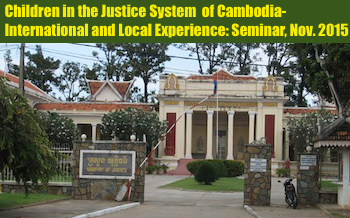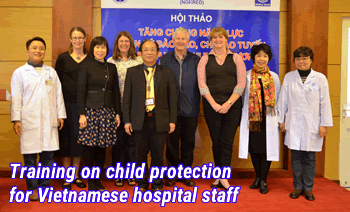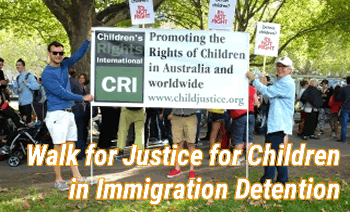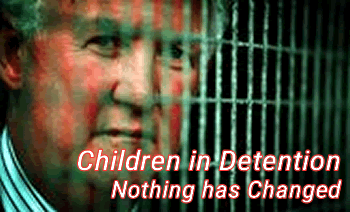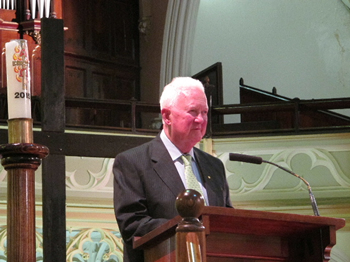
Friday 31st July 2015
I am conscious of the brilliant eulogy to Michele delivered by Jeff McMullen at the service to commemorate her life in Sydney and the touching contribution of Pia Pagotto from ‘concerned Australians’ at this event and will not attempt to emulate them here.
I thought today I would just say a few words about my relationship with Michele and her wonderful ‘concerned Australians.
I start with a confession that I was something of a latecomer to Aboriginal and Torres Strait Islander issues before my appointment as Chief Justice of the Family Court of Australia. Because of the significance of children to the work of the Family Court and my concern that it was not reaching out to the Indigenous people of Australia I took a number of steps to try to correct that situation.
This is not the place to discuss those measures but that involvement did teach me much about the remarkable qualities of the Aboriginal and Torres Strait Islander people and also to form a better appreciation as to how they have been shamefully neglected and mistreated.
To me that neglect and mistreatment culminated in the Howard Government’s 2007 intervention, which was an entirely spurious exercise based upon false premises, which effectively shattered the morale and lifestyle of the Aboriginal people of the NT.
The election of the Rudd government seemed to me and many others to usher in a new dawn, particularly having regard to PM Rudd’s well-crafted and significant apology delivered at Parliament House.
Unfortunately those expectations were soon dispelled, for me by Michele. I was approached by Michele in 2009 to assist her as a result of a suggestion to her from my old friend and colleague, Judge John Hassett. She wanted me to examine so-called consultations carried out in the NT between June and August 2009 at the instance of the Rudd Government and in particular the then Minister for Aboriginal Affairs, Jenny Macklin. The purpose of them was to gain Aboriginal support for the continuation of a number of quite objectionable features of the Intervention. This they failed to do. I quickly became horrified by the shamefully inadequate and insulting nature of those consultations. I then worked further with Michele and others on the issue and that in turn led to the production of the Report, Will they be heard? Co-authored by Professor Larissa Behrendt, Alison Vivian, Nicole Watson, Michele and me. That report was launched by the late Malcolm Fraser, former Prime Minister of Australia, in November 2009 and provided a withering condemnation of what the Government had done.
With all respect to the other participants, that report would never have come about without Michele. It was she who arranged for recording and transcripts of a selection of the consultations which graphically demonstrated their inadequacy. It was she who brought together the many senior Aboriginal critics of the consultations. It was she who enlisted the involvement of Malcolm Fraser and me and the Research Unit at the Jumbunna Indigenous House of Learning from the University of Technology, Sydney.
All of that was a considerable achievement but Michele was by no means finished with the matter. In February 2010 she produced the first of a series of five books, this one being entitled “This Is What We Said”. Each of them was beautifully set out and told the real story, largely through Aboriginal eyes and in their own words. She did so because she wanted to keep faith with the Aboriginal people and to tell the world what they had in fact said as distinct from the Government version of its sham consultations.
There followed many similar events and further publications, in all of which Michele played a leadership role. There were a number of visits and presentations by Aboriginal Elders in Melbourne organised by Michele and ‘concerned Australians’, all of which were well attended but largely ignored by metropolitan media, a development that drove me to Twitter and Facebook for the first time in an attempt to redress the balance.
Visiting Michele and Ed’s home it was common to find people such as Rosalie Kunoth Monks and Djiniyini Gondarra and others actually staying there, often for substantial periods. It was Michele who organised a visit by the two of them to the UN Human Rights Committee meeting in Geneva and persuaded the Quakers to provide them with support and accommodation whilst they were there. She also prevailed upon me to assist them with the writing of their submission and I very nearly finished up there myself.
Michele had a wonderful rapport with Aboriginal people, especially from her beloved Arnhem Land but from elsewhere as well and they clearly held mutual friendship and respect for her. This enabled her to achieve far more than others could have done in an area where many others have tried and failed
In an email to me written by my friend former Justice Sally Brown, who is here today, she commented about Michele:
“Michele was a remarkable woman; passionate, committed and, I discovered, impossible to say NO to; true it is that one could say the word, but she had a rare capacity not to hear it and continue as if the answer had been YES all along!”
That perfectly sums up Michele as all of us who were privileged to know her can testify.
She had great determination but also great patience. I well remember a joint statement that we drafted with Malcolm Fraser in relation to the Rudd Government’s second series of so called Stronger Futures Consultations which went into 22 drafts before it went out to the many actual signatories who then made their own suggestions. Remarkably, it was released on 27 June 2011 five days after the Government’s public announcement of the consultations and the day before the consultations were to commence. In the next stage of that correspondence with the Minister we reduced the number of signatories to six which helped a bit.
This round of consultations was if anything worse than the first round, the Department having learned nothing from what went before, apart from a few superficial improvements that did not go to the substance of the problem. The problem was and continues to be that when Governments purport to consult with Aboriginal people they do not do so at all but simply invite them to comment on already predetermined outcomes. Consultation tends to be rushed and based on insufficient information to the people and the communication is often in English only.
The second joint public Report about those consultations, “Listening but not Hearing” involved most of the original authors with some additions including Paddy Gibson and Eva Cox.
The Report was again launched by Malcolm Fraser at Melbourne University. Its primary conclusions were that the Stronger Futures consultation process did not comply with Australia’s obligations to consult with Aboriginal and Torres Strait Islander Peoples. The Government was attempting to use the consultations to justify its legislative retention of aspects of the Intervention as special measures for the protection of Aboriginal peoples, but the consultations fell well short of doing so. These conclusions were in line with the evidence given by Aboriginal people to a subsequent Senate Committee examining the legislation.
Once again Michele, through ‘concerned Australians’, played a leading role in initiating and carrying through this project.
Michele produced another great book on these consultations, “NT Consultation Report 2011”. It gained its strength from the many quotations from Aboriginal people as to what they thought of the consultations. The comments as to what they felt about the Government’s proposal to cease funding homelands resonate today when the Abbott Government is making a further assault upon those homelands.
Needless to say the Stronger Futures legislation was passed into law despite the unified opposition of Aboriginal people and this in turn led to another book from Michele, “A Decision to Discriminate- Aboriginal Disempowerment in the Northern Territory”, published in September 2012. This largely consisted of what Aboriginal People said to the Senate Committee examining their views of the Stronger Futures legislation and the consultations that led to it. She pointed out the deficiencies in the Committee recommendations and once again the Aboriginal people may have been listened to but had not been heard.
In her final book “In the Absence of Treaty”, published in December 2013, Michele dealt with the vexed subject of land and the efforts of others to reduce Aboriginal control of what remains of their lands. In it she dealt with the threat to Community Living Areas and the Report of the Parliamentary Joint Committee on Human Rights.
Her conclusion was that it was well and truly time for a government with strong leadership to sit down with Aboriginal people from across the country to negotiate the real terms of engagement and that symbolism like the Apology and the Welcome to Country can never, on its own be other than hollow offerings in the absence of a legally binding contract or treaty. She said that we should not forget that Australia is the only Commonwealth country that does not have a treaty with its First Peoples.
Following this book she went on to pick up the theme of the need for a treaty as the only way in which Aboriginal Rights can be safely preserved, and the last communication that I had from her was one of a series relating to the Treaty issue.
Given the enormous amount that Michele contributed to the process of challenging the Intervention and its aftermath it is hard to imagine that she had much time for anything else. However being Michele she found time.
For example she provided great assistance to Djiniyini Gondarra in pursuing a land claim on behalf of his Yolngu people of Arnhem Land and typically, enlisted me to use my contacts to arrange pro bono legal assistance for him in proceedings in the Federal Court. Her assistance also went to the raising of substantial funds to pay for disbursements not covered by the pro bono grant. Unfortunately those proceedings were unsuccessful.
On another occasion she took up the case of a Papua-New Guinean mother in child welfare proceedings between her and the relevant Department in Canberra concerning her children. She called on me to help in typical Michele style. Fortunately a Canberra solicitor that I knew made himself available without charge and was able to successfully resist the Department in court and the children stayed with the mother.
I mention these matters because they show that while Michele was heavily engaged in the wider issues, she always found time to help individuals in need.
To me one of the most remarkable things about Michele is that she achieved all that I have outlined while suffering from a serious and debilitating kidney disease that required constant and lengthy hospital treatment, often on a daily basis. She never complained and tended to brush off inquiries as to her health.
Apart from her own strength she had one great asset and that was her husband Ed who gave her enormous support and was always there to help. They had a wonderful relationship and without his support she would have had great difficulty in achieving what she did.
Similarly I am sure that she would like me to pay tribute to ‘concerned Australians’ and the dedication and support that they offered to her. They are a fine group of people with a strong social conscience who I am sure will want to carry on the work that she did so well.
I am honoured to have been associated with her and to have had the opportunity of paying her this public tribute. She was a unique person who stood out as one who was prepared to do something constructive to oppose injustice to our First Peoples at a time when others who should have been doing so were silent. I believe that the work that she has done for them will be remembered and that history will afford her a significant place in furthering their long struggle for justice.











